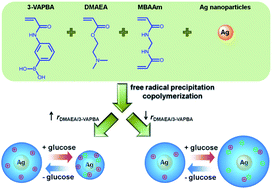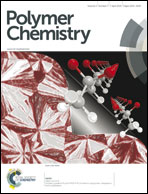Tailoring the glucose-responsive volume phase transition behaviour of Ag@poly(phenylboronic acid) hybrid microgels: from monotonous swelling to monotonous shrinking upon adding glucose at physiological pH†
Abstract
We develop a class of polymer–inorganic hybrid microgels, comprising Ag nanoparticle cores covered by a poly(3-acrylamidophenylboronic acid-co-2-(dimethylamino)ethyl acrylate) [p(3-VAPBA-co-DMAEA)] gel shell, to demonstrate that the volume phase transition behaviour of poly(phenylboronic acid) gels can be tailored from exhibiting monotonous swelling to monotonous shrinking upon adding glucose at a physiological pH of 7.4, via varying the feeding ratio of monomers DMAEA (introducing positive charges by ionization) to 3-VAPBA (introducing negative charges through the formation of a glucose–boronate complex) in the synthesis. The counterbalance of the positive and negative charges at particular glucose concentrations is a key parameter to enable this tailoring. Accompanied by this tailoring, the photoluminescence of the hybrid microgels is tuned from glucose-responsive “turn-off” to “turn-on”, in which the latter displays an improved glucose-sensing performance in both artificial tear fluid (a model for low glucose concentrations) and urine (for high glucose concentrations).


 Please wait while we load your content...
Please wait while we load your content...